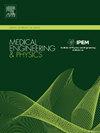基于代理体的最小应力屏蔽髋关节假体定位优化
IF 1.7
4区 医学
Q3 ENGINEERING, BIOMEDICAL
引用次数: 0
摘要
应力屏蔽现象在植入植体的骨骼中引起应力分布的不良变化。这种现象导致种植体附近的骨密度逐渐下降,最终松动。为提高假体的耐久性和推迟翻修手术,假体的设计和定位应使植入后骨内应力分布尽可能接近自然分布。我们将实现接近正态应力分布的问题表述为约束优化问题,其中植入前后应力分布的差异构成损失函数,五个位置和尺寸参数,包括股骨前倾角,颈轴角度,股骨头偏移,杯型和杯倾角构成设计变量集。采用有限元分析方法得到了植入前后骨内的应力分布。为了创建FE模型,首先使用CT图像创建患者髋关节的三维模型。然后将模型置于患者步态分析得到的载荷下,并在植入前后骨骼的临界点处计算应力屏蔽指数(SSI)。植入前后SSI值的差异定义了成本函数。为了减少大量成本函数评估的计算成本,采用代理模型(5 × 1 MLP神经网络)来预测成本函数的值。实验设计(DOE)用于对设计变量的超空间进行采样,并生成训练、测试和验证数据。利用遗传算法求解优化问题,并将优化结果与最佳初始样本集的结果进行比较。结果表明,该方法显著减小了种植前后应力分布的差异,应力屏蔽指数降低了12%。本文章由计算机程序翻译,如有差异,请以英文原文为准。
Surrogate-based positioning optimization of hip prostheses for minimal stress shielding
The stress shielding phenomenon causes undesirable changes in stress distribution in the bones in which implants are implanted. This phenomenon leads to a gradual decrease in bone density in the vicinity of the implant and ultimately loosening. To improve the endurance of the prosthesis and postpone the revision surgery the prosthesis should be designed and positioned in such a way that the post-implant stress distribution within the bones is as close to the natural distribution as possible.
We formulate the problem of achieving a near-normal stress distribution as a constrained optimization problem in which the difference between pre- and post-implant stress distributions constitutes the loss function and five positional and dimensional parameters, including Femoral Anteversion, Neck Shaft Angle, Femoral Head Offset, Cup Version, and Cup Inclination comprise the set of design variables. Finite Elements (FE) analysis is used to obtain the stress distribution in bones before and after the implantation. To create a FE model, first a three-dimensional model of the patient's hip is created using CT images. The model is then subjected to the loads obtained from the patient's gait analysis, and the Stress Shielding Index (SSI) is calculated at critical points of the bones before and after the implantation. The difference between pre- and post-implant SSI values defines the cost function. To reduce the computational cost of numerous cost function evaluations a surrogate model (a 5 × 1 MLP neural network) is employed to predict the value of the cost function. Design Of Experiments (DOE) is used to sample the hyperspace of the design variables and generate training, test and validation data. The optimization problem is solved using Genetic Algorithms and the results are compared with the results of the best set of initial samples.
Results from the proposed approach show a significant reduction in the difference between pre- and post-implant stress distributions and a 12 % reduction in the Stress Shielding Index.
求助全文
通过发布文献求助,成功后即可免费获取论文全文。
去求助
来源期刊

Medical Engineering & Physics
工程技术-工程:生物医学
CiteScore
4.30
自引率
4.50%
发文量
172
审稿时长
3.0 months
期刊介绍:
Medical Engineering & Physics provides a forum for the publication of the latest developments in biomedical engineering, and reflects the essential multidisciplinary nature of the subject. The journal publishes in-depth critical reviews, scientific papers and technical notes. Our focus encompasses the application of the basic principles of physics and engineering to the development of medical devices and technology, with the ultimate aim of producing improvements in the quality of health care.Topics covered include biomechanics, biomaterials, mechanobiology, rehabilitation engineering, biomedical signal processing and medical device development. Medical Engineering & Physics aims to keep both engineers and clinicians abreast of the latest applications of technology to health care.
 求助内容:
求助内容: 应助结果提醒方式:
应助结果提醒方式:


